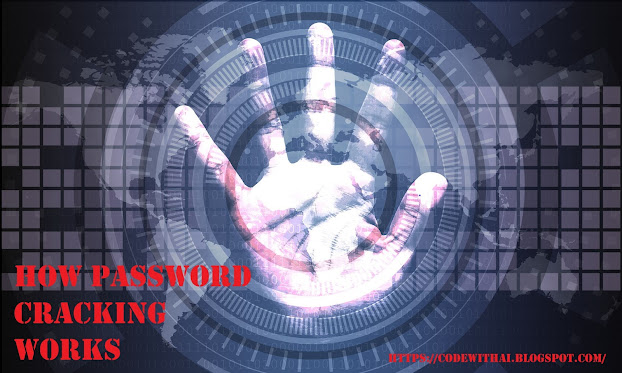how it's work
The typical process followed by a password cracker includes these
four steps:
Steal passwords by some nefarious means. That password is
encrypted before it is stored using a hash. Hashes are mathematical
functions that transform an input of arbitrary length into an
encrypted fixed-length output.
Choose a cracking method, such as a brute-force or dictionary
attack, and choose a cracking tool.
Prepare password hashes for cracking programs. This is done by
providing an input to the hash function to create a hash that can be
authenticated.
Run the cracking tool.
A password cracker may also be able to identify encrypted
passwords. After retrieving the password from the computer's
memory, the program may be able to decrypt it. Or, using the same
algorithm as the system program, the password cracker creates an
encrypted version of the password that matches the original.
password attack
1. Brute force attack
A brute
force password attack is essentially a guessing game where the hacker tries
various password combinations using the hacking software until they are able to
crack the code. These hackers hope that their victims either reuse a password
that has already been compromised or use a common phrase such as
"12345".
2. Credential Stuffing
Credential
stuffing is also a type of brute force attack that uses stolen credentials to
break into your online accounts and profiles. In addition to using spyware and
other types of malware to get what they want, the dark web often contains lists
of compromised passwords for cybercriminals to use for their devious schemes. .
Hackers can use these lists to carry out their credential stuffing schemes and
exploit your data.
3.
Social Engineering
Cyber
thieves have a variety of skills - one of which is creating trustworthy
websites. Password hackers create what are known as social engineering websites
that they design to look like legitimate login pages. These cyber criminals
send you to a fake login field that will not give you access to your account.
It only records the information you type, giving cyber criminals exactly what
they want.,
4. Dictionary Attack
Another
sibling of the brute force attack family is the dictionary attack. These cyber
attacks play on our habit of using single-word phrases as our passwords. The
hacker can use automated password-guessing software to try each word in a
dictionary as your password to see if they have any luck.
More
advanced dictionary attacks Hackers develop a list of keywords specific to your
life, such as birth dates, siblings/pet names, and/or past street names.
5. Keylogger Attack
A
keylogger is spyware that is used to track and record what you type on your
keyboard. Despite being legal to use, based on logic, hackers take advantage of
this software by intentionally infecting vulnerable devices and recording
private information without their knowledge.
6. Data Leak or Password Spray Attack
Password
spraying is when a hacker uses a large number of stolen passwords – sometimes
in the millions – on a small number of online accounts to see if they can gain
access. Hackers use advanced automated password-guessing software that limits
the number of attempts that can be made on an account. This prevents them from
triggering security alerts and continues to try under the radar.
7.phishing
Password
phishing attacks often come in the form of emails or text messages, diverting
your attention to an urgent matter. The hacker may combine these messages with
a link to a strategically designed social engineering website designed to trick
you into logging into their profile. These websites will record the credentials
you type in, giving an attacker direct access to your real account.
8. Man-in-the-middle attack
A
man-in-the-middle attack uses phishing messages to pose as a legitimate
business in order to accomplish the following goals:
Use
malicious attachments to install spyware and record passwords
Embed
links to social engineering websites to trick people into compromising their
credentials
9. Traffic Interception
Traffic
interception is also a type of man-in-the-middle attack. This is when password
crackers eavesdrop on network activity to capture passwords and other types of
sensitive information. There are several ways cyber criminals do this, one of
which is to monitor unsecured Wi-Fi connections. But they can also use a tactic
called SSL hijacking – when a cyber criminal intercepts the connection between
a target and the legitimate site they are on and records any information shared
between the two.
10. Shoulder surfing
Being
aware of your physical surroundings is just as important as spotting suspicious
activity online. One way hackers get passwords is by looking over people's
shoulders in public as they type. People often focus on entering their password
only to find that a nosy neighbor is looking out for them.
















